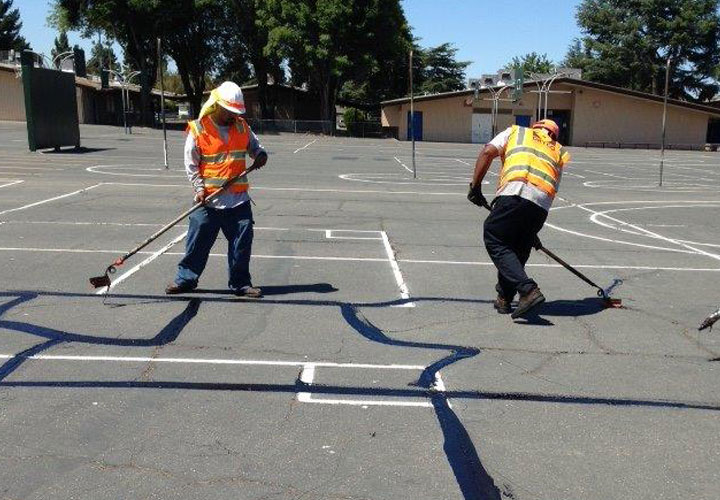Mastering Angled Parking: How Asphalt Sealing Improves Business Whole Lots
Hot Mix Asphalt: A Lasting Solution for Sidewalk
Hot Mix Asphalt (HMA) has actually emerged as a leading lasting option for pavement remedies, providing a myriad of environmental advantages and innovative technologies. As the need for environmentally friendly building and construction methods grows, discovering the subtleties of HMA's sustainability can offer beneficial insights right into the future of pavement solutions.
Ecological Advantages of Hot Mix Asphalt

Additionally, Warm Mix Asphalt helps to minimize metropolitan warm island results. Its dark color absorbs sunshine, decreasing the quantity of warmth showed back right into the environment contrasted to lighter-colored pavements. This can reduce ambient temperature levels in urban locations, lowering the need for air conditioning and inevitably lowering energy consumption.
Furthermore, Hot Mix Asphalt adds to enhanced stormwater management. Its porous nature permits water to recharge and penetrate the pavement groundwater materials, reducing overflow and the danger of flooding. These environmental benefits make Hot Mix Asphalt a sustainable choice for paving highways and roads.
Energy Performance in HMA Production
Is energy effectiveness an important consider the manufacturing of Warm Mix Asphalt (HMA)? Absolutely. Power plays a significant role in the production of HMA, influencing both expense and ecological sustainability. One essential aspect of power efficiency in HMA manufacturing is using warm mix asphalt (WMA) modern technologies (regrading). WMA enables the mixing and positioning of asphalt at lower temperature levels contrasted to standard warm mix asphalt, leading to lowered power intake throughout manufacturing. This procedure not only decreases gas usage yet likewise reduces greenhouse gas emissions, making it a more eco-friendly choice.
Additionally, improvements in plant technologies have led to more energy-efficient HMA production procedures. By optimizing energy use in HMA manufacturing, the market can minimize its carbon footprint while preserving premium sidewalk materials.
Recyclability of Warm Mix Asphalt
The recyclability of Hot Mix Asphalt (HMA) is a critical element of its sustainability and long-term ecological influence. HMA is one of one of the most recycled materials in the USA, with over 100 million bunches of reclaimed asphalt sidewalk (RAP) being recycled each year in brand-new pavement building and construction. Reusing HMA provides several ecological advantages, such as reducing the requirement for virgin materials, lowering power usage throughout production, and find out decreasing the quantity of waste sent out to land fills.
The procedure of reusing HMA involves milling the existing sidewalk, crushing it into smaller sized items, and mixing it with new aggregate and asphalt binder to produce a recycled mix. This recycled mix can commonly execute along with or perhaps much better than conventional HMA, while needing less basic materials and producing lower greenhouse gas emissions. By including RAP into brand-new pavement tasks, roadway agencies can preserve natural deposits, lower prices, and lessen the ecological impact of roadway building and maintenance activities. On the whole, the recyclability of HMA plays a substantial role in advertising sustainable practices within the pavement industry.

Long-Term Efficiency of HMA
Asphalt sidewalks demonstrate durability and strength over an extended period, mirroring the Going Here long-term efficiency of Hot Mix Asphalt (HMA) Additionally, advancements in HMA modern technology, such as the use of polymer-modified binders and warm mix asphalt, have even more improved the durability and long life of HMA pavements. By prioritizing high quality building and construction and maintenance methods, HMA proceeds to prove itself as a sustainable and cost-efficient solution for durable sidewalk framework.

HMA: Toughness and Sustainability
Demonstrating both durability and sustainability, Hot Mix Asphalt (HMA) has actually become a foundation in the building of lasting pavement facilities - commercial parking lot paving. HMA's durability stems from its capacity to hold up against heavy lots, severe climate conditions, and high web traffic quantities, making it a reputable choice for streets, highways, and airport terminal paths. The composition of HMA, which usually consists of accumulations, binder, and filler, plays a critical function in boosting its longevity and resistance to tear and put on
Moreover, HMA's sustainability depends on its recyclability and energy-efficient manufacturing procedure. The capacity to reuse recovered asphalt sidewalk (RAP) in new HMA mixes minimizes the need for virgin products and lessens the ecological impact of pavement building and construction and upkeep. Furthermore, the energy effectiveness look at these guys of producing HMA hinges on its lower mixing temperatures contrasted to various other sidewalk materials, leading to minimized power intake and greenhouse gas emissions.
Final Thought
In conclusion, hot mix asphalt (HMA) uses a lasting remedy for pavement with its ecologically friendly attributes. HMA's recyclability, power efficiency in manufacturing, and long-lasting toughness make it a green choice for road building. By preserving natural deposits, reducing waste, and decreasing greenhouse gas exhausts, HMA plays a vital role in advertising sustainability in framework growth. Its capability to mitigate urban warmth island effects further emphasizes its importance in developing ecologically conscious and resilient pavement systems.
HMA is one of the most recycled materials in the United States, with over 100 million lots of redeemed asphalt sidewalk (RAP) being reused yearly in new sidewalk construction.The process of recycling HMA involves grating the existing sidewalk, squashing it into smaller sized pieces, and blending it with new aggregate and asphalt binder to develop a recycled mix.Asphalt sidewalks demonstrate longevity and strength over an extended duration, showing the long-lasting performance of Warm Mix Asphalt (HMA) In addition, advancements in HMA innovation, such as the use of polymer-modified binders and cozy mix asphalt, have additionally enhanced the resilience and durability of HMA sidewalks. The capacity to reuse redeemed asphalt pavement (RAP) in new HMA combinations minimizes the need for virgin products and reduces the environmental effect of pavement construction and maintenance.